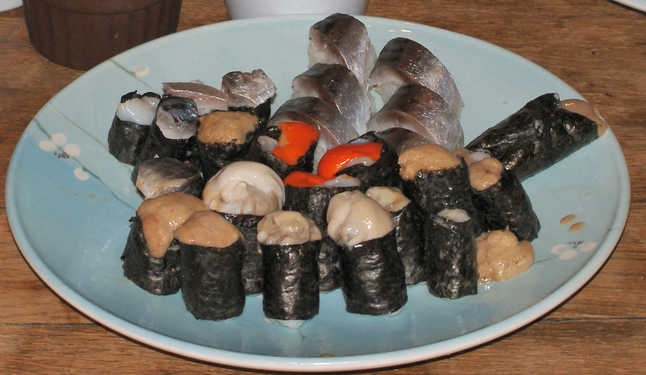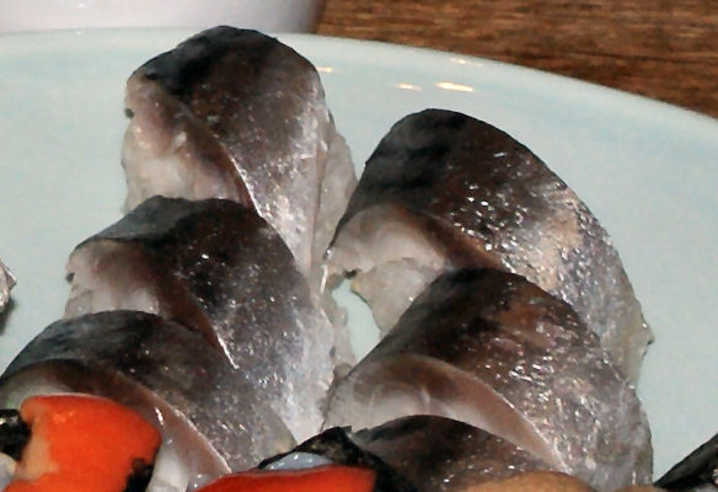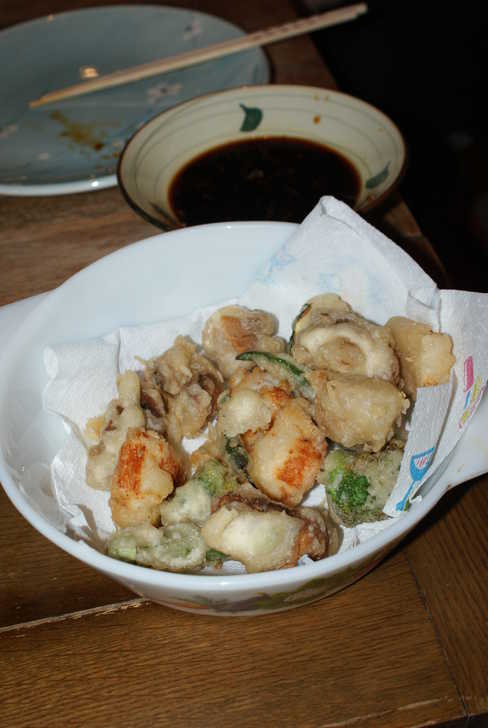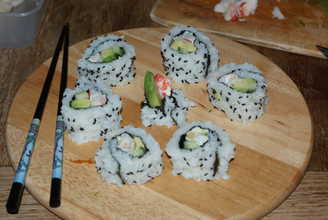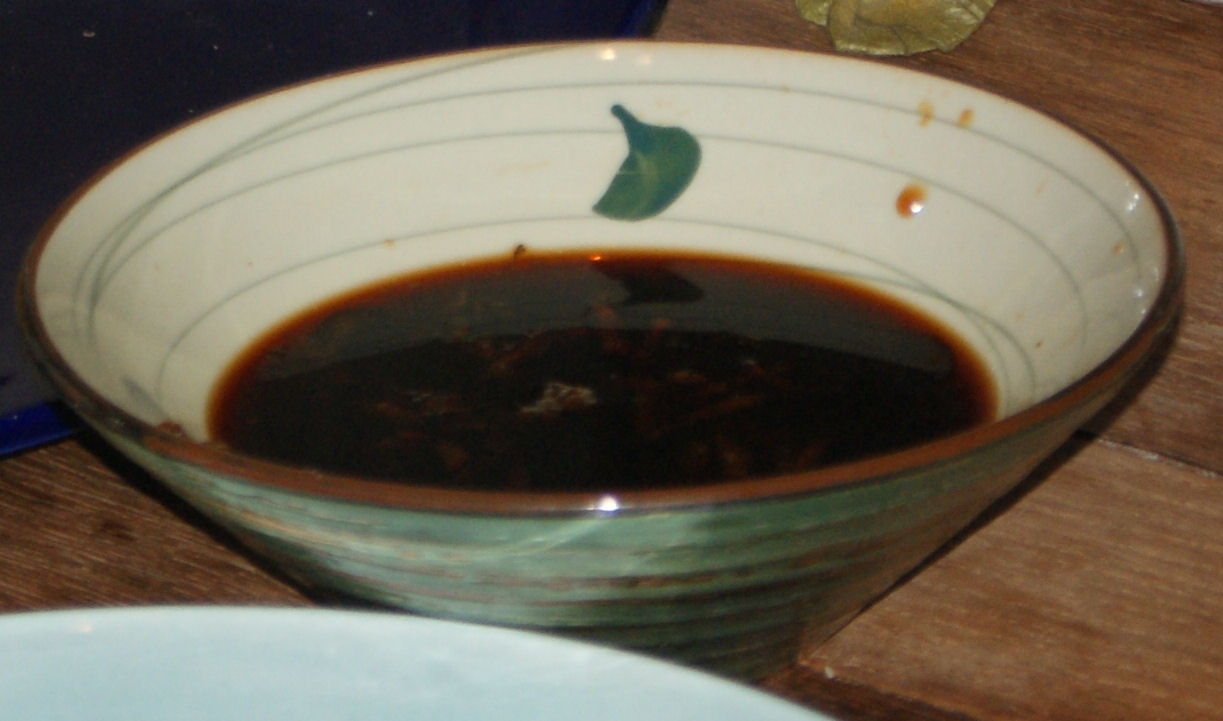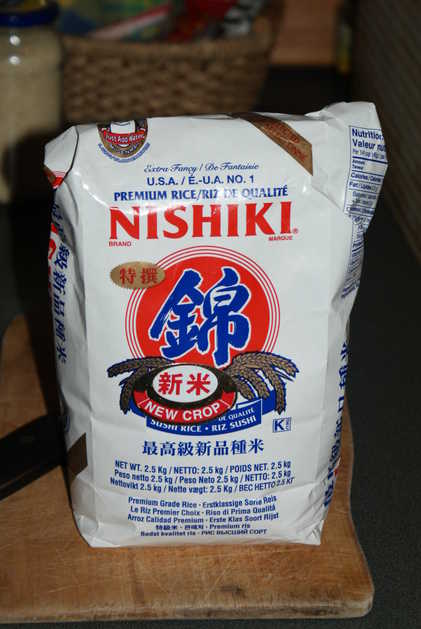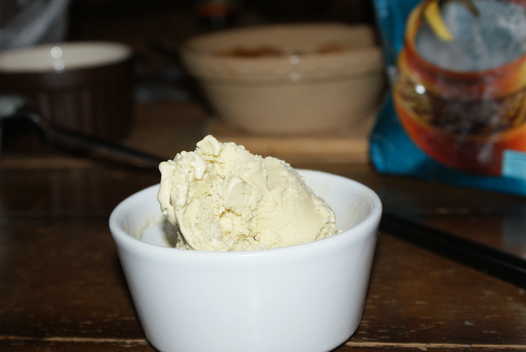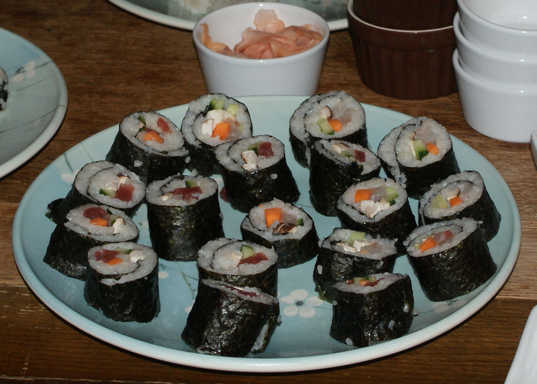
Sushi Reunion
Sushi and Tempura go so well together - they use pretty much the same ingredients -
certainly if you can sushi it you can tempura it.
Though I'm not sure the reverse is true.
This meal was for Sophie who was obviously deeply impressed by our first sushi meal and never stopped reminding me that I'd promised her another.
I'm indebted to Kimiko Barber and Hiroki Takemura's solid Sushi: taste and technique for its many preparation tips and sushi ideas.
Though I'm not sure the reverse is true.
This meal was for Sophie who was obviously deeply impressed by our first sushi meal and never stopped reminding me that I'd promised her another.
I'm indebted to Kimiko Barber and Hiroki Takemura's solid Sushi: taste and technique for its many preparation tips and sushi ideas.
Menu
Starter
Clear Soup with Sea Bass
Sushi
Rolled Sushi
Hot Stuff
Baked Scallop Dynamite
Dessert
Green Tea and Wasabi Ice Cream
Clear Soup with Sea Bass
Sushi
Rolled Sushi
The regular kind.
California Sushi
The Californian kind.
Gunboat Sushi
Like jewelled battleships.
Pickled Mackerel Log RollHot Stuff
Baked Scallop Dynamite
They're baked, they've got scallops in them and they're dynamite!
Assorted TempuraDessert
Green Tea and Wasabi Ice Cream
Just a hint of wasabi. Honest!
Rolled Sushi (makizushi)
main fish
Serve with pickled pink sushi ginger, soy sauce and wasabi paste and a little dish for each guest to mix up their preferred dip.
Ingredients
- sushi nori
- sushi rice
- wasabi
Fishies:- tuna
- sea bass
- salmon
- prawns
Vegetables:- cucumber matchsticks
- spring onion
- asparagus
- mooli (daikon)
- shiitake mushrooms, preferably reconstituted from dried
- carrot matchsticks
- avocado slices
Reconstitute the dried shiitake mushrooms, if using:
- Soak 1 oz (30g) dried shiitake mushrooms in 8 fl oz (250ml) hot water for about 20 minutes. Drain, reserving the soaking liquid, and cut off and discard the stems.
Add the mushrooms to 8 fl oz (250ml) dashi and the reserved liquid in a saucepan, and cook over a gentle heat for about 30 minutes or until the liquid has reduced by half. Add 1 tablespoon mirin, then remove from the heat and let cool in the liquid before using.
Gut and scale the fish (if you've bought them whole), fillet them, remove their skin if necessary and cut into strips.
Cut your vegetables into strips or matchsticks.
To make the sushi rolls:
Lay a sheet of seaweed (nori) on a bamboo rolling mat, shiny side down. You can put a layer of cling film on the mat first if you like.
Cover the sheet with a thin layer of sushi rice by pressing balls of rice gently but firmly across the seaweed using fingers moistened with sushi vinegar. You should still be able to see the seawood through the rice. Leave a bare strip about 1 or 2 inches wide at the far side of the sheet so the roll will seal closed, and it's not a bad idea to do the same at the closer end to make it easier to get the roll going.
Now choose your fish, or if you hate fish, choose your ham, lay a line across the middle of the sheet and a selection of your vegetables. You can also rub a (tiny) smear of wasabi along the rice if you want.
It's your sushi - you can put in what you want.
When you are satisfied just start rolling the sushi up from the near side, folding the edges in and rolling back the bamboo mat so you don't roll the mat and the cling film inside as you go! Keep a firm pressure across the mat to produce a firm tight roll.
Now slice the roll into about 6 or 8 segments using a sharp, wet knife and you have just made futomaki!
- Soak 1 oz (30g) dried shiitake mushrooms in 8 fl oz (250ml) hot water for about 20 minutes. Drain, reserving the soaking liquid, and cut off and discard the stems.
Add the mushrooms to 8 fl oz (250ml) dashi and the reserved liquid in a saucepan, and cook over a gentle heat for about 30 minutes or until the liquid has reduced by half. Add 1 tablespoon mirin, then remove from the heat and let cool in the liquid before using.
You can use the (strained) liquid as the base for your tempura dipping sauce.
Gut and scale the fish (if you've bought them whole), fillet them, remove their skin if necessary and cut into strips.
Cut your vegetables into strips or matchsticks.
To make the sushi rolls:
Lay a sheet of seaweed (nori) on a bamboo rolling mat, shiny side down. You can put a layer of cling film on the mat first if you like.
Cover the sheet with a thin layer of sushi rice by pressing balls of rice gently but firmly across the seaweed using fingers moistened with sushi vinegar. You should still be able to see the seawood through the rice. Leave a bare strip about 1 or 2 inches wide at the far side of the sheet so the roll will seal closed, and it's not a bad idea to do the same at the closer end to make it easier to get the roll going.
Now choose your fish, or if you hate fish, choose your ham, lay a line across the middle of the sheet and a selection of your vegetables. You can also rub a (tiny) smear of wasabi along the rice if you want.
It's your sushi - you can put in what you want.
When you are satisfied just start rolling the sushi up from the near side, folding the edges in and rolling back the bamboo mat so you don't roll the mat and the cling film inside as you go! Keep a firm pressure across the mat to produce a firm tight roll.
Now slice the roll into about 6 or 8 segments using a sharp, wet knife and you have just made futomaki!
An alternative rolled sushi called hosomaki are much thinner rolls, usually made using only one filling
and a half-sheet of the nori.
Gunboat Sushi
main fish
Standing proud with their fillings presented like glistening jewels these delicate sushi are both beautiful and delicious.
Without being the least bit genital.
Without being the least bit genital.
Ingredients
- prepared sushi rice
- nori strips
- sea urchins
- oysters
- scallops and their coral
- salmon eggs (Ikura) if you can get them
Prepare the sea urchins (uni)
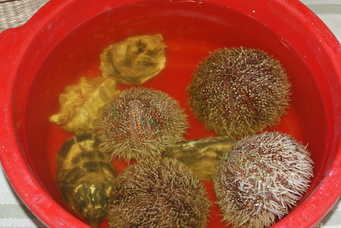 Having bought my sea urchins the day before I decided to keep them overnight in a bowl of fresh water with the oysters
- which might have been a mistake. While oysters and mussels seem to thrive on this sort of treatment -
allowing them to flush themselves clean
(or perhaps not?),
the sea urchins turned a rather odd green colour
and exuded some strange yellowy pus from the top (opposite their mouths - which I believe is their bumhole).
Having bought my sea urchins the day before I decided to keep them overnight in a bowl of fresh water with the oysters
- which might have been a mistake. While oysters and mussels seem to thrive on this sort of treatment -
allowing them to flush themselves clean
(or perhaps not?),
the sea urchins turned a rather odd green colour
and exuded some strange yellowy pus from the top (opposite their mouths - which I believe is their bumhole).
Looking around on the web it seems they are very sensitive to salinity, so I probably killed them with freshness. One site declares that Sea urchins can stay alive in the fridge for several days in an uncovered bowl. (though another suggests covering with a damp towel) so maybe you would be better off doing that - assuming they were alive to start with.
The fishmonger (who seemed as uncertain as I) selected the heaviest ones on the assumption that they were most likely to be still alive! I've also seen it suggested that you can judge an urchin by his spines - the more rigid they are, the fresher the urchin.
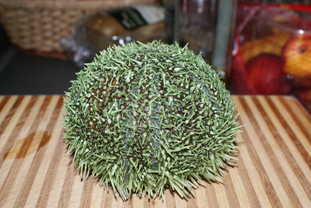 When you are ready to use the sea urchins, hold the urchin in an old tea towel with it's pouty mouth parts uppermost.
Take a pair of sturdy scissors or poultry shears and dig them in around the soft mouth area and cut a decent-sized hole in the shell.
Pull away any of the black organs and pour away the liquid which should leave visible five orange or yellow lobes of its genitals.
Carefully scoop these away as whole as possible with a sharp-edged teaspoon. They are quite difficult to separate from the shell,
and where they are cut they seem to lose quite a lot of their frothy orange content, so try and keep them intact.
When you are ready to use the sea urchins, hold the urchin in an old tea towel with it's pouty mouth parts uppermost.
Take a pair of sturdy scissors or poultry shears and dig them in around the soft mouth area and cut a decent-sized hole in the shell.
Pull away any of the black organs and pour away the liquid which should leave visible five orange or yellow lobes of its genitals.
Carefully scoop these away as whole as possible with a sharp-edged teaspoon. They are quite difficult to separate from the shell,
and where they are cut they seem to lose quite a lot of their frothy orange content, so try and keep them intact.
Keep the lobes chilled on ice or in the fridge until needed.
Prepare your other seafood
Open your oysters and free their bodies, making absolutely sure you don't have any bits of shell with them. Neaten them up with a sharp knife if they look a bit stringy or untidy.
Keep them on ice or in the fridge (use their cleaned shells) until needed.
Remove the coral (orange bit) from your scallops, carefully teasing out the thin black intestine that runs along part of its length with the point of a knife or a tooth pick. Neatly trim a scallop or two, removing any of the hard muscle, bits of loose skin or darkish flesh and black intestine. Slice these scallops horizontally into thin discs and set aside with the corals until needed.
Make the gunboats
Gunboat shushis (Gunkanmaki) are a kind of hand-formed sushi (nigirizushi) that just consist of ovals of rice wrapped in seaweed (nori) with a little space left at the top to hold your chosen filling:
Cut or tear a sheet of nori into strips (they are often perforated for this purpose). Moisten your fingers with water or sushi vinegar, form a small ball of rice into a flattened rugby ball shape and then roll up in a strip of nori, using grains of rice to hold the end closed. Leave a little gap at one end.
Now fill this pocket with what you fancy
- a smear of wasabi paste, slice of scallop and a fat orange coral,
- a squeeze of lemon and a nice plump oyster, not really eaten in Japan though we thought they were rather nice
- a blob of sea urchin gonads My personal favourite. Hmmmm sea urchin gonads.
- or maybe a pile of fishy eggs.
 Having bought my sea urchins the day before I decided to keep them overnight in a bowl of fresh water with the oysters
- which might have been a mistake. While oysters and mussels seem to thrive on this sort of treatment -
allowing them to flush themselves clean
(or perhaps not?),
the sea urchins turned a rather odd green colour
and exuded some strange yellowy pus from the top (opposite their mouths - which I believe is their bumhole).
Having bought my sea urchins the day before I decided to keep them overnight in a bowl of fresh water with the oysters
- which might have been a mistake. While oysters and mussels seem to thrive on this sort of treatment -
allowing them to flush themselves clean
(or perhaps not?),
the sea urchins turned a rather odd green colour
and exuded some strange yellowy pus from the top (opposite their mouths - which I believe is their bumhole).Looking around on the web it seems they are very sensitive to salinity, so I probably killed them with freshness. One site declares that Sea urchins can stay alive in the fridge for several days in an uncovered bowl. (though another suggests covering with a damp towel) so maybe you would be better off doing that - assuming they were alive to start with.
The fishmonger (who seemed as uncertain as I) selected the heaviest ones on the assumption that they were most likely to be still alive! I've also seen it suggested that you can judge an urchin by his spines - the more rigid they are, the fresher the urchin.
 When you are ready to use the sea urchins, hold the urchin in an old tea towel with it's pouty mouth parts uppermost.
Take a pair of sturdy scissors or poultry shears and dig them in around the soft mouth area and cut a decent-sized hole in the shell.
Pull away any of the black organs and pour away the liquid which should leave visible five orange or yellow lobes of its genitals.
Carefully scoop these away as whole as possible with a sharp-edged teaspoon. They are quite difficult to separate from the shell,
and where they are cut they seem to lose quite a lot of their frothy orange content, so try and keep them intact.
When you are ready to use the sea urchins, hold the urchin in an old tea towel with it's pouty mouth parts uppermost.
Take a pair of sturdy scissors or poultry shears and dig them in around the soft mouth area and cut a decent-sized hole in the shell.
Pull away any of the black organs and pour away the liquid which should leave visible five orange or yellow lobes of its genitals.
Carefully scoop these away as whole as possible with a sharp-edged teaspoon. They are quite difficult to separate from the shell,
and where they are cut they seem to lose quite a lot of their frothy orange content, so try and keep them intact.Keep the lobes chilled on ice or in the fridge until needed.
Prepare your other seafood
Open your oysters and free their bodies, making absolutely sure you don't have any bits of shell with them. Neaten them up with a sharp knife if they look a bit stringy or untidy.
Keep them on ice or in the fridge (use their cleaned shells) until needed.
Remove the coral (orange bit) from your scallops, carefully teasing out the thin black intestine that runs along part of its length with the point of a knife or a tooth pick. Neatly trim a scallop or two, removing any of the hard muscle, bits of loose skin or darkish flesh and black intestine. Slice these scallops horizontally into thin discs and set aside with the corals until needed.
Make the gunboats
Gunboat shushis (Gunkanmaki) are a kind of hand-formed sushi (nigirizushi) that just consist of ovals of rice wrapped in seaweed (nori) with a little space left at the top to hold your chosen filling:
Cut or tear a sheet of nori into strips (they are often perforated for this purpose). Moisten your fingers with water or sushi vinegar, form a small ball of rice into a flattened rugby ball shape and then roll up in a strip of nori, using grains of rice to hold the end closed. Leave a little gap at one end.
Now fill this pocket with what you fancy
- a smear of wasabi paste, slice of scallop and a fat orange coral,
- a squeeze of lemon and a nice plump oyster, not really eaten in Japan though we thought they were rather nice
- a blob of sea urchin gonads My personal favourite. Hmmmm sea urchin gonads.
- or maybe a pile of fishy eggs.
Yumsk.
Pickled Mackerel Log Roll Sushi
main pickle fish
A Japanese lightly pickled Mackerel for sushi
You can prepare the mackerel up to six hours in advance.
Then use it to make pressed sushi oshi zushi if you have a rectangular sushi mould,
otherwise make log roll sushi, but leave time to let the roll stand for 30 minutes at room temperature before cutting
to allow the flavours to develop.
Makes about two dozen sushi. Which is a lot.
Ingredients
- 4 mackerel fillets (from 2 fish), about 5 oz (150g) each
- about 8 tablespoons sea salt
- 16 fl oz (500ml) rice vinegar
- sushi rice
- 2 tablespoons mirin or 3 tablspoons granulated sugar
- 2 teaspoons salt
Place the mackerel fillets in a large bowl, and pour over the salt.
Gently rub the mackerel fillets with the salt, ensuring they are evenly covered.
Place the fillets on a bamboo strainer or in a colander. Leave for at least 30 minutes, preferably an hour, to allow juices drawn out by the salt to drain off. Rinse under cold running water, and pat dry with paper towels.
Mix together the vinegar, mirin or sugar, and salt in a plastic or glass bowl large enough to hold the fillets. Add the mackerel to the bowl and set aside to marinate for 1-2 hours.
Take the fillets out of the vinegar mixture, and pat dry with paper towels. The flesh should have whitened. Slowly peel off the papery thin outer skin, starting at the head. Don't worry if some of the iridescent underskin also comes off.
Place the fillets on a cutting board, and run the tips of your fingers lightly up and down them to feel for any small bones. Use tweezers to remove any that you find, and a sharp knife to trim and shape the fillets, if necessary.
Cover a bamboo rolling mat with cling film.
Wet your hands with vinegared water, place two small handfuls of rice in the centre of the mat and shape into a mackerel-length log.
Dab the underside of the mackerel with a little wasabi, if you like. Place the fillet on top of the mound of rice, skin-side up.
Lift the mat over the rice and mackerel so that it is completely covered.
Work your hands along the length of the sushi log, squeezing it firmly but gently. If the mackerel is longer than the rice, neaten it by pressing the ends of the fish over so that they stick to the rice.
Set aside to stand for 20 minutes at room temperature.
Moisten a sharp knife with vinegared water using a cloth and slice the log into bite-sized pieces.
Place the fillets on a bamboo strainer or in a colander. Leave for at least 30 minutes, preferably an hour, to allow juices drawn out by the salt to drain off. Rinse under cold running water, and pat dry with paper towels.
Mix together the vinegar, mirin or sugar, and salt in a plastic or glass bowl large enough to hold the fillets. Add the mackerel to the bowl and set aside to marinate for 1-2 hours.
Take the fillets out of the vinegar mixture, and pat dry with paper towels. The flesh should have whitened. Slowly peel off the papery thin outer skin, starting at the head. Don't worry if some of the iridescent underskin also comes off.
Place the fillets on a cutting board, and run the tips of your fingers lightly up and down them to feel for any small bones. Use tweezers to remove any that you find, and a sharp knife to trim and shape the fillets, if necessary.
Cover a bamboo rolling mat with cling film.
Wet your hands with vinegared water, place two small handfuls of rice in the centre of the mat and shape into a mackerel-length log.
Dab the underside of the mackerel with a little wasabi, if you like. Place the fillet on top of the mound of rice, skin-side up.
Lift the mat over the rice and mackerel so that it is completely covered.
Work your hands along the length of the sushi log, squeezing it firmly but gently. If the mackerel is longer than the rice, neaten it by pressing the ends of the fish over so that they stick to the rice.
Set aside to stand for 20 minutes at room temperature.
Moisten a sharp knife with vinegared water using a cloth and slice the log into bite-sized pieces.
Really rather nice, and extremely pretty too.
Baked Scallop Dynamite
main side fish
Seafood (typically scallops or mussels) baked in a spicy mayonaisse sauce.
I first tasted a seafood dynamite in a little sushi bar I used to frequent in Manhattan's lower east side,
and remember just how fantastic it was, but I've never had a go at making one before,
and until I looked them up, didn't really have any idea what was in one.
There seem to be a small number of fairly similar recipes for dynamite sauce out there - all of them are based on mayonnaise, some kind of seafood (usually scallops or mussels) and most of them adding masago (tiny bright orange fish eggs). According to one authority - their name derives from the popping noise made by the cooking eggs, but I'd definitely list that under apocryphal.
Most of the recipes just add a little sauce to cover a scallop or a mussel on its shell and then bake it, but the version I remember from the sushi bar was baked in a shallow tin foil container.
The version I made was really tasty, but it became very watery - so either you could try smaller individual servings, or add something to absorb the fluid such as courgette (though that might just make things worse), par-cooked potato, mooli or cauliflower.
Also it was a little bit gritty - I'm not sure whether that was because of actual grit in my mushrooms or scallops, or it might have been the black sesame seeds - which are rather small and gravelly. So maybe I could do without them.
There seem to be a small number of fairly similar recipes for dynamite sauce out there - all of them are based on mayonnaise, some kind of seafood (usually scallops or mussels) and most of them adding masago (tiny bright orange fish eggs). According to one authority - their name derives from the popping noise made by the cooking eggs, but I'd definitely list that under apocryphal.
Most of the recipes just add a little sauce to cover a scallop or a mussel on its shell and then bake it, but the version I remember from the sushi bar was baked in a shallow tin foil container.
The version I made was really tasty, but it became very watery - so either you could try smaller individual servings, or add something to absorb the fluid such as courgette (though that might just make things worse), par-cooked potato, mooli or cauliflower.
Also it was a little bit gritty - I'm not sure whether that was because of actual grit in my mushrooms or scallops, or it might have been the black sesame seeds - which are rather small and gravelly. So maybe I could do without them.
Round two: I missed out the black sesame seeds and there a notable lack of grittiness,
so I'd leave those out unless you are a particular fan.
I also tried baking scallop dynamite over a pre-baked layer of different sliced vegetables, most of which were quite nice, but didn't do much to soak up the watery juices generated during cooking. So I think serving with rice might be the way to go...
Oddly enough - the water seems to be re-absorbed into the sauce once it cools back down again.
I also tried baking scallop dynamite over a pre-baked layer of different sliced vegetables, most of which were quite nice, but didn't do much to soak up the watery juices generated during cooking. So I think serving with rice might be the way to go...
Oddly enough - the water seems to be re-absorbed into the sauce once it cools back down again.
Serves 4
Ingredients
- 12 scallops, sliced
- ½ cup QP mayonnaise
- 1 tablespoon sesame oil
- 1 tsp rice vinegar
- ½ teaspoon wasabi powder
- 1-1½ tablespoons soy sauce
- white sesame seeds
Variations:- mussels
- lobster/crab/prawns, shredded
- shiitake mushrooms, sliced
- Sriracha (Asian chili) sauce
- courgettes, sliced
- masago (Capelin or Smelt roe)
In a small bowl, mix the mayonnaise, sesame oil, rice vinegar, wasabi powder, soy sauce and some white sesame seeds.
Add chili sauce to taste.
Variation 1: Single dish
Slice the scallops into thin discs and reserve chilled in a bowl until needed.
Take half of the dynamite sauce and mix with the sliced scallops. I added sliced shiitake mushrooms and some sea urchin roe. I would have added some masago if I'd had any.
Place this mixture in shallow dishes (or use scallop or oyster shells) and bake at about 350°F/175°C/Gas Mark 4 for 8 minutes or until the sauce bubbles and turns golden brown.
Top off with the remaining dynamite sauce and finish by grilling for three minutes until the surface browns and bubbles.
Variation 2: Gratin style
Slice the scallops into thin discs and mix with all the dynamite sauce (I don't think it makes any difference adding an extra layer of sauce for grilling). Add your optional extras (slices of shiitake mushrooms, sea urchin roe, fish eggs etc). Line small heatproof dishes with thin slices of your vegetable of choice. I've tried:
Variation 3: Individual servings
Instead of filling a large(ish) dish, just put a piece of seafood on its shell (scallop/mussel/oyster), dress with the dynamite sauce and bake or grill until hot, bubbling and starting to brown.
Variation 1: Single dish
Slice the scallops into thin discs and reserve chilled in a bowl until needed.
Take half of the dynamite sauce and mix with the sliced scallops. I added sliced shiitake mushrooms and some sea urchin roe. I would have added some masago if I'd had any.
Place this mixture in shallow dishes (or use scallop or oyster shells) and bake at about 350°F/175°C/Gas Mark 4 for 8 minutes or until the sauce bubbles and turns golden brown.
Top off with the remaining dynamite sauce and finish by grilling for three minutes until the surface browns and bubbles.
Variation 2: Gratin style
Slice the scallops into thin discs and mix with all the dynamite sauce (I don't think it makes any difference adding an extra layer of sauce for grilling). Add your optional extras (slices of shiitake mushrooms, sea urchin roe, fish eggs etc). Line small heatproof dishes with thin slices of your vegetable of choice. I've tried:
- courgettes Ok. Nothing special
- mushrooms Adds nothing, since I've already got mushrooms in the mixture.
- cauliflower quite tasty
- mooli an interesting contrast
I think there might be an oriental cauliflower/mooli gratin dish lurking here!
Variation 3: Individual servings
Instead of filling a large(ish) dish, just put a piece of seafood on its shell (scallop/mussel/oyster), dress with the dynamite sauce and bake or grill until hot, bubbling and starting to brown.
The flavour is most definitely reminiscent of these dishes at that New York Sushi bar,
but I don't remember them being quite so watery.
Watery but delicious!
Watery but delicious!
It might be worth trying out adding a little tahini to the mix too?
Tempura
main starter fish veg vegan
Battered things. Deep fried.
Sushi and Tempura go great together: you can more-or-less deep-fry anything you don't end up sushi-ing,
and it's a great way of using up the leftovers. Provided they aren't cut up too small.
Hint: keep the oil hot 170-175°C/340-350°F and the batter cold.
Hint: keep the oil hot 170-175°C/340-350°F and the batter cold.
Ingredients
- tempura batter no. 8
- groundnut (peanut) oil for deep-frying
Any of:- non-oily fish
- prawns
- scallops
- oysters seems a bit of a waste though...
- squid
- aubergine
- mushrooms Not Shiitake - I tried those. They're rubbish
- broccoli
- cauliflower
- courgettes
- carrots
- yams
- sweet potato
- daikon (mooli) surprisingly good
- green beans
- onion
- red pepper
- okra a particularly tasty way to cook okra
- whole chillies
- sprouts nope - don't go there!
To Serve:- tempura dipping sauce
You need to go for tempura pieces about bite-sized.
Peel the prawns (feel free to leave the very tips of the tail on to give you something to hang on to) neatly trim the flesh where the head was and cut out the dark vein of intestines all along their backs.
Clean the scallops, trim away any hard white parts and save the coral for something else.
Open your oysters and free the flesh - trimming any straggly bits.
Leave the okra whole.
Core and deseed the pepper and split into bite-sized pieces.
Break the broccoli and cauliflower into largish florets.
Cut large mushrooms in half or quarters.
Make sure that rooty vegetables: carrots, yams, sweet potatoes, daikon, even aubergines and courgettes, are sliced quite thinly (about ½") so that they will cook through.
You can make clumps of thinner vegetables such as green beans by glueing them together with batter.
The onions are tricky - I think you really need onion rings for them to work. If you leave them whole, even small ones like shallots, they're just too slimy
Whole green chillies are quite good, if you can stand the heat, but pierce them (and any other watery, thick-skinned vegetables) so that they don't explode and cover you in boiling hot fat. 'Cos that hurts.
Sprouts are awful! Throw them away.
Mix the batter up immediately before using it, and make it up in batches that you can use up fairly quickly.
Heat the oil to between 170°C/340°F and 180°C/360°F.
Coat your morsels with the tempura batter and drop them into the hot oil in batches (first roll any moist ingredients - fish or seafood - in a layer of rice flour in a shallow bowl). You can drizzle extra batter on top of each tempura if you want some extra crunchy bits. The tempura should sink briefly and then rise to the surface bubbling. Try to keep the lumps separated so they don't stick together and keep the oil between 170°C/340°F and 180°C/360°F.
Lift the tempura out and set them to drain when they've turned golden and crisped up nicely, first in a metal seive, then on paper towels.
Serve immediately with tempura dipping source for each guest.
Peel the prawns (feel free to leave the very tips of the tail on to give you something to hang on to) neatly trim the flesh where the head was and cut out the dark vein of intestines all along their backs.
Clean the scallops, trim away any hard white parts and save the coral for something else.
Open your oysters and free the flesh - trimming any straggly bits.
Leave the okra whole.
Core and deseed the pepper and split into bite-sized pieces.
Break the broccoli and cauliflower into largish florets.
Cut large mushrooms in half or quarters.
Make sure that rooty vegetables: carrots, yams, sweet potatoes, daikon, even aubergines and courgettes, are sliced quite thinly (about ½") so that they will cook through.
You can make clumps of thinner vegetables such as green beans by glueing them together with batter.
The onions are tricky - I think you really need onion rings for them to work. If you leave them whole, even small ones like shallots, they're just too slimy
Whole green chillies are quite good, if you can stand the heat, but pierce them (and any other watery, thick-skinned vegetables) so that they don't explode and cover you in boiling hot fat. 'Cos that hurts.
Sprouts are awful! Throw them away.
Mix the batter up immediately before using it, and make it up in batches that you can use up fairly quickly.
Heat the oil to between 170°C/340°F and 180°C/360°F.
Coat your morsels with the tempura batter and drop them into the hot oil in batches (first roll any moist ingredients - fish or seafood - in a layer of rice flour in a shallow bowl). You can drizzle extra batter on top of each tempura if you want some extra crunchy bits. The tempura should sink briefly and then rise to the surface bubbling. Try to keep the lumps separated so they don't stick together and keep the oil between 170°C/340°F and 180°C/360°F.
Lift the tempura out and set them to drain when they've turned golden and crisped up nicely, first in a metal seive, then on paper towels.
Serve immediately with tempura dipping source for each guest.
California Sushi Roll
main fish
Sushi roll of lobster (or crab), avocado and cucumber
One small lobster and one avocado made about two dozen rollsIngredients
- cooked lobster (or crab), sliced into strips or shredded
- avocado, cut into sticks
- lemon juice, to sprinkle on the avocado
- cucumber, cut into matchsticks optional
- QP mayonnaise or the regular kind, if you don't have QP
- wasabi
- chives
- sushi rice
- sushi nori
Decoration:- tobiko (flying fish roe)
- black or white sesame seeds
- poppy seeds
Prepare your ingredients - slicing the avocado and sprinkling it with lemon juice.
Slicing or shredding the crab or lobster.
Cutting the cucumber into matchsticks.
Now lay a half sheet of nori (full sheets seem a bit unmanageable) shiny side down on a piece of cling film on top of a bamboo mat and spread with sushi rice, leaving an inch or two clear at the side closest to you.
Sprinkle the rice with your decoration of choice (though I suppose you could roll the sushi in it afterwards if you prefer). Place a second piece of cling film on top of the sheet, and a second bamboo rolling mat if you have one and flip the sheet so that the rice is on the lower side (and the clear edge is still towards you).
Now lay out a line of your fillings across the seaweed just after where the clear gap is. Rub a smear of wasabi across the sheet, then a line of mayonnaise my own addition - I think it works well then a line of crab, a line of of avocado and a line of cucumber and chives. Or whatever you like really - you're in charge.
Next carefully roll up the sushi, starting with the clear edge which you can fold over to get the whole thing started. Try not to roll the bamboo mat or the cling film inside as well. Carefully peel off the cling film, roll around in your decoration if you didn't add it already and slice the roll into 6 or 8 rounds with a sharp, wet knife.
Eat.
Now lay a half sheet of nori (full sheets seem a bit unmanageable) shiny side down on a piece of cling film on top of a bamboo mat and spread with sushi rice, leaving an inch or two clear at the side closest to you.
Sprinkle the rice with your decoration of choice (though I suppose you could roll the sushi in it afterwards if you prefer). Place a second piece of cling film on top of the sheet, and a second bamboo rolling mat if you have one and flip the sheet so that the rice is on the lower side (and the clear edge is still towards you).
Now lay out a line of your fillings across the seaweed just after where the clear gap is. Rub a smear of wasabi across the sheet, then a line of mayonnaise my own addition - I think it works well then a line of crab, a line of of avocado and a line of cucumber and chives. Or whatever you like really - you're in charge.
Next carefully roll up the sushi, starting with the clear edge which you can fold over to get the whole thing started. Try not to roll the bamboo mat or the cling film inside as well. Carefully peel off the cling film, roll around in your decoration if you didn't add it already and slice the roll into 6 or 8 rounds with a sharp, wet knife.
Eat.
Yep they're not exactly Japanese - but they're awesome.
Dashi
sauce veg
Japanese stock
Makes 1 litreIngredients
- 1 litre water
- 1 or two to taste heaped tablespoon hon-dashi granules
- or about ⅔ oz dried bonito flakes katsuobushi
- 1 piece kombu
Put the water in a deep pot and soak the the kombu for about 10 minutes.
Put the pot on low heat and remove the kombu just before the water boils.
Add the bonito flakes, skim off any foam and turn off the heat.
Let the stock sit until the bonito flakes sink, then strain the stock.
Or just add the dashi granules.
Let the stock sit until the bonito flakes sink, then strain the stock.
Or just add the dashi granules.
Actually I just gently simmered up the water with the kombu and granules,
but then I'm just a gaijin.
Tempura Dipping Sauce
dip veg vegan
You can quickly make a dipping sauce by just mixing up half soy sauce and half mirin with a little water,
but this version with dashi is a great improvement.
Serves 6
Ingredients
- 1 cup dashi or 1 cup water and about 1 teaspoon dashi granules
- ¼ cup mirin
- ¼ cup soy sauce Shoyu preferably
- ½ tablespoon sugar If you like. I didn't seem to need it.
- a handful (¼ cup or so) grated daikon (mooli) to taste
- grated ginger to taste
Mix up the liquid ingredients.
If you need to use dashi granules, or add sugar you will probably need to heat the mixture to a boil. If so, let the sauce cool before continuing.
Add the grated daikon and ginger and serve in individual bowls.
If you need to use dashi granules, or add sugar you will probably need to heat the mixture to a boil. If so, let the sauce cool before continuing.
Add the grated daikon and ginger and serve in individual bowls.
Rather tasty. I didn't add any ginger, but the daikon is nice.
I didn't need to heat the mixture up either.
I didn't need to heat the mixture up either.
Clear Soup with White Fish
soup fish
I made this with Sea Bass.
Leaving the skin on the fish helps it to keep its shape and look pretty.
Leaving the skin on the fish helps it to keep its shape and look pretty.
Serves 4
Ingredients
- 1 litre dashi
- 1 tbsp light soy sauce
- 1 tbsp mirin
- 4 oz (125g) white fish fillets - red snapper, sole or sea bass - cut into 8 pieces
- 4 spring onions, finely sliced
- salt
Bring the dashi to a boil in a small saucepan. Add the soy sauce, mirin and salt to taste.
Reduce the heat and simmer gently.
Add the fish to the pan and bring back to a boil, then immediately remove from the heat.
Put two pieces of fish skin-side-up in each individual bowl.
Gently ladle the soup over the fish, garnish with the sliced spring onions, and serve.
Add the fish to the pan and bring back to a boil, then immediately remove from the heat.
Put two pieces of fish skin-side-up in each individual bowl.
Gently ladle the soup over the fish, garnish with the sliced spring onions, and serve.
Surprisingly tasty.
Sushi Rice
side staple veg vegan
Sushi sucks up a whole load of rice. A whole load.
One cup per person seems barely to scratch the surface.
Use about 15% more water than rice by volume.
One cup per person seems barely to scratch the surface.
Use about 15% more water than rice by volume.
Makes about 4 large sushi rolls (futomaki) or 10 small rolls (hosomaki)
Ingredients
- 2 cups (500ml - about 20 oz/600g) rice
- 2⅓ cups (600ml) water
- 1 postcard-sized piece of kombu optional
For the sushi vinegar:- ¼ (4 tbsps/60ml) cup japanese rice vinegar
- 2 tablespoons (30ml) sugar or 1 tablespoon (15ml) sugar and ½ tablespoon (7ml) mirin, sake or sweet brandy
- ½ teaspoon salt
- or
- ¼ cup bottled sushi vinegar :)
Prepare the rice
Wash the rice thoroughly but gently in several changes of water until the water runs clear. You can do this with the rice in a seive.
Leave the rice to drain in the seive for 30 minutes until it is quite dry.
Put the rice and the water in a heavy-bottomed pot. If you're using kombu make a few cuts in it and add that too. Bring to the boil, then cover with a tight-fitting lid and boil over high heat for a minute or two, stirring once or twice. Stir, turn the heat down as low as it will go, seal and cook for 10 or 15 minutes without removing the lid If you can help it. Obviously you won't be able to resist the odd peek, and if you smell burning then all bets are off. or until the surface of the rice is clear.
Turn off the heat and let the rice stand, without opening, for 15-20 minutes. Discard the kombu.
Meanwhile make the sushi vinegar
Heat the ingredients in a small preferably non-aluminium saucepan, stirring until the salt and sugar have dissolved.
Do not boil.
Set aside to cool.
Spread the rice in a wooden tub or a salad bowl. Add about ¼ of the sushi vinegar and fold in gently with a wooden spatula, then gradually add in the rest. (The idea of all this wood is that is will absorb excess moisture from the rice.)
Now fan the rice gently to cool it (you can use an electric fan!) as you turn it with the spatula for 5 or 6 minutes until the rice looks glossy and has cooled almost to room temperature. Use a slicing action to coat the grains and separate them but avoid crushing them.
Wash the rice thoroughly but gently in several changes of water until the water runs clear. You can do this with the rice in a seive.
Leave the rice to drain in the seive for 30 minutes until it is quite dry.
Put the rice and the water in a heavy-bottomed pot. If you're using kombu make a few cuts in it and add that too. Bring to the boil, then cover with a tight-fitting lid and boil over high heat for a minute or two, stirring once or twice. Stir, turn the heat down as low as it will go, seal and cook for 10 or 15 minutes without removing the lid If you can help it. Obviously you won't be able to resist the odd peek, and if you smell burning then all bets are off. or until the surface of the rice is clear.
Turn off the heat and let the rice stand, without opening, for 15-20 minutes. Discard the kombu.
Meanwhile make the sushi vinegar
Heat the ingredients in a small preferably non-aluminium saucepan, stirring until the salt and sugar have dissolved.
Do not boil.
Set aside to cool.
Spread the rice in a wooden tub or a salad bowl. Add about ¼ of the sushi vinegar and fold in gently with a wooden spatula, then gradually add in the rest. (The idea of all this wood is that is will absorb excess moisture from the rice.)
Now fan the rice gently to cool it (you can use an electric fan!) as you turn it with the spatula for 5 or 6 minutes until the rice looks glossy and has cooled almost to room temperature. Use a slicing action to coat the grains and separate them but avoid crushing them.
Or you can just use your hands to gently massage the sushi vinegar into the rice
while lifting and spilling the grains in the air from the fan - much more satisfying, and probably more effective.
Keep the rice at a cool room temperature covered with a damp cloth or cling film for up to 12 hours.
But the sooner you use it the better of course.
Cooking for a sixteen-year-old's birthday sushi party, I took my own advice and used 10 cups of rice for ten people,
but they ate like mice. Like mice. And I ended up with enough leftover sushi rice to build an igloo,
and that was after heaving great handfuls of it into my day-after-sushi soup.
I reckon I would have had plenty with only ½ cup per person - so be warned and tune your quantities accordingly.
Also, the cooking directions above don't scale terribly well when making enormous quantities of rice.
It's hard to get the water and rice boiling in the first place before the whole pot turns to glue, and even harder to leave it over a direct, if low, heat without the bottom burning.
I started with relatively more boiling water (than the proportions above) in a large pot, adding the drained rice to it, and trying to bring it back to the boil for a few minutes. I then put the covered pot in a very low oven for 15 minutes rather than attempting to simmer it. The rice came out a bit on the sticky side but otherwise acceptable.
Perhaps for large amounts of rice you need to move away from the absorption method and start thinking about boiling it in a larger quantity of water, draining it after, then again leaving it to finish in the oven à la Pat Chapman?
I reckon I would have had plenty with only ½ cup per person - so be warned and tune your quantities accordingly.
Also, the cooking directions above don't scale terribly well when making enormous quantities of rice.
It's hard to get the water and rice boiling in the first place before the whole pot turns to glue, and even harder to leave it over a direct, if low, heat without the bottom burning.
I started with relatively more boiling water (than the proportions above) in a large pot, adding the drained rice to it, and trying to bring it back to the boil for a few minutes. I then put the covered pot in a very low oven for 15 minutes rather than attempting to simmer it. The rice came out a bit on the sticky side but otherwise acceptable.
Perhaps for large amounts of rice you need to move away from the absorption method and start thinking about boiling it in a larger quantity of water, draining it after, then again leaving it to finish in the oven à la Pat Chapman?
Green Tea and Wasabi Ice Cream
dessert veg
The wasabi was really Aidan's idea - it adds a tiny frisson of pepperiness to the ice cream which works rather well.
Don't overdo it though. Add it to the custard at the end and taste as you go.
You can miss it out if you're chicken.
I couldn't find any of the proper green tea powder so I used some sweetened instant green tea powder instead. About 8 teaspoons (40g) of the stuff - so it's obviously quite a bit less potent than the real stuff. And not as green either - all the green tea ice cream I've seen has been practically luminous, but mine was more avocado, or maybe khaki.
Still tasted pretty good though.
You can miss it out if you're chicken.
I couldn't find any of the proper green tea powder so I used some sweetened instant green tea powder instead. About 8 teaspoons (40g) of the stuff - so it's obviously quite a bit less potent than the real stuff. And not as green either - all the green tea ice cream I've seen has been practically luminous, but mine was more avocado, or maybe khaki.
Still tasted pretty good though.
For my second attempt I treated myself to some quality matcha,
and what a difference it makes! The flavour is now strong and distinctive with the advertised 10g
(indeed you might even want to use a touch less), and the colour a terrific vivid green.
It's more difficult to get the matcha powder to dissolve though, so thoroughly grind it to a paste with small quantities of milk before beating it into your cream or custard. You might need to strain out any recalcitrant undissolved lumps.
It's more difficult to get the matcha powder to dissolve though, so thoroughly grind it to a paste with small quantities of milk before beating it into your cream or custard. You might need to strain out any recalcitrant undissolved lumps.
Makes about 750ml
Ingredients
- 4 tsps (10g) green tea powder (matcha) apparently!
- ½ teaspoon wasabi powder !
- 250ml double cream (or one of those small 300ml tubs)
- 250ml milk
- 6 egg yolks though I used 5 since one broke - and it seemed fine
- 100g sugar
- pinch of salt
Pour a few tablespoons of the cream into a large bowl and whisk in the green tea powder
or start with adding a little milk and beating the powder to a paste before straining it into the cream.
In a separate bowl beat together the egg yolks and sugar until they turn pale golden and you can draw a figure of eight across the surface.
Heat the rest of the cream, the milk, and salt in a saucepan, stirring, until it comes to simmering point. Pour slowly into the egg mixture, whisking until well blended then return the mixture back to the pan.
Slowly heat the custard to 80°C/175°F, stirring constantly. At this point it should thicken to the consistency of double cream, and coat the back of a spoon. Your finger should be able to draw a line through the mixture on the back of the spoon that will make a definite parting.
Strain the custard into a bowl and beat in the flavoured whipped cream, and then gradually add wasabi powder to taste (I quite understand if your taste is for none at all).
Cover the bowl with cling film and chill until ready to freeze.
Keep it in the freezer until required, but for best results leave it to soften at room temperature for 10 minutes before serving, or keep it in the fridge for half an hour.
In a separate bowl beat together the egg yolks and sugar until they turn pale golden and you can draw a figure of eight across the surface.
Heat the rest of the cream, the milk, and salt in a saucepan, stirring, until it comes to simmering point. Pour slowly into the egg mixture, whisking until well blended then return the mixture back to the pan.
Slowly heat the custard to 80°C/175°F, stirring constantly. At this point it should thicken to the consistency of double cream, and coat the back of a spoon. Your finger should be able to draw a line through the mixture on the back of the spoon that will make a definite parting.
Strain the custard into a bowl and beat in the flavoured whipped cream, and then gradually add wasabi powder to taste (I quite understand if your taste is for none at all).
Cover the bowl with cling film and chill until ready to freeze.
I chilled my custard in the freezer for 2 hours (with a stir in the middle),
but you might have a freezer that actually works!
Or longer time to wait for it to chill in the fridge.
When the custard is sufficiently chilled, crank up your ice cream machine and churn the custard into ice cream.Or longer time to wait for it to chill in the fridge.
Keep it in the freezer until required, but for best results leave it to soften at room temperature for 10 minutes before serving, or keep it in the fridge for half an hour.
Universally praised - and I don't think it was only because their memories still burned with my recent attempt at
crab ice cream.
